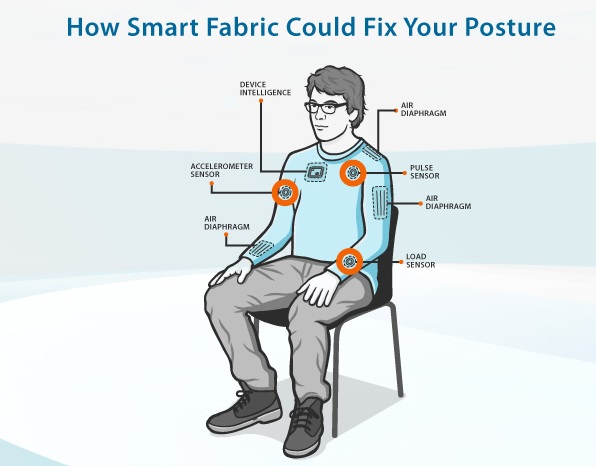For Gopi Krishna Durbhaka of HCL Technologies, the idea came to him during one of his most routine tasks: the daily train commute – a rather uncomfortable one at that.
“I thought it would be good to bring comfort to individuals in a similar situation to me,” explained Durbhaka, “and that’s how I ended up with this invention.”
The invention in question is wearable technology designed to improve a person’s posture. While new wearables seem to be introduced daily – everything from medical devices that analyze and send vital signs to doctors, to shoes that electronically lace themselves – Durbhaka and his research team decided to look to a new realm of wearables by employing information technology in fabric.
Currently patent-pending, Durbhaka’s smart fabric methodology uses built-in sensors, processors and a Proportional-Integral-Derivative (PID) controller to help wearers with posture ergonomics.
First, sensors are placed within the interior of the fabric along key body parts in need of posture regulation – including the neck, the shoulders, under the knees, the lower back, beneath and around the waist, the legs, around the ankles and underneath the head. There are three different types of sensors within the fabric including accelerometer sensors that detect posture, load sensors that capture movement, and pulse sensors that monitor body vitals.

Once data from these body parts are sensed, a processor captures the posture ergonomics and movement data. Integrated with an Adaptive Resonance Theory analytical model, the processor determines the user’s posture and provides a PID controller with instructions on where there is a lack of stability in the body. The PID controller, coupled with the processor, is configured to dynamically control the air diaphragms. These air diaphragms are placed within the fabric and include an air pump and valve, which can inflate and deflate the fabric based on the input computed through the Adaptive Resonance Theory analytical model.
Based on each individual’s body type, the processor is configured to provide a user with maximum comfort depending on their position – sitting, standing or sleeping – and in relation to information stored on the processor from past usage. This smart fabric can be useful in situations where a body might see regular strain such as in a bed, sitting for long periods of time, in a hospital room, or, as with our inventor, on public transportation for daily commutes to work.
“A lot of what we see now in smart fabrics is thermoregulation – fabric that cools down and heats up – which could be achieved in our own bodies through biological processes,” Durbhaka said, “but this invention caters to an issue that our bodies can’t address without external resources.”
Durbhaka’s smart fabric also includes the added thermoregulation and monitors for vital signs to ensure the wearer is both comfortable and healthy.
Once produced, gone are the days of needing pillows and foot rests for support, as this smart fabric will work towards improved posture and reduced pain for wearers — two benefits that could expand far beyond a daily train commute.
For more information on smart fabric, visit the IEEE Xplore Digital Library.





